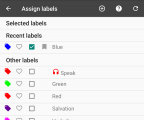| « It's about Jesus | Technophilia » |
InDesign Wrapping
While working on The Bell Chronicles annual newsletter I learned or was reminded about some things in InDesign CS2 that you might be interested in.
1. The Flag The first issue had to do with adding drop shadows to text. I wanted a section with the title of the publication in a red type with a drop shadow all on an ivory background. Many of you InDesign users may know that InDesign can be used to create drop shadows for type (and other things) inside a text frame. That works great if you don't have a background. If you add a background color to that text frame though the drop shadow will be around the frame. The fix for that is really simple make a second frame the size of the area to be defined with a background color and place it underneath the text of the title.
Here's the steps to follow. Create text frame for the Title text. Add Text. Drop Shadow. Duplicate frame Add background color Send background frame to back Set Text Wrap to None.
2. The Graphic To add to the mix I also wanted to add a graphic in the corner on top of this area bleeding off on the top and left edge. I had the Title text centered in the frame. With the addition of the graphic I had two options. Did I want the text to still be centered in the frame or between the edge of the graphic and the edge of the frame? In order to have the type centered between the graphic and the edge of the text frame I set the text wrap of the graphic to wrap around object shape. Text wrap options not only set aside space for an object so that they don't overlap but they also define new boundaries for other objects.
If I had wanted to center in the frame I just select to ignore text wrap in Table Frame Options (Ctrl-B) of the Title text frame. If the text was long enough to reach the graphic you might have to bring the type forward (or to top) in order for it to overlap the graphic. Of course you might choose to have the graphic overlap the type.
3. Event/Location text To make it even more complex I had two lines below the text frame with the top line running under the graphic. Between the two lines I had Christmas 2006 and Tyler Texas at each end of a text frame. (Remember lines can have wrapping too.)
This is a pretty straightforward design but using a combination of overlapping text frames with text wrap in different modes and some frames ignoring text wrap you can create some neat effects while still being organized about it.
Fine Tuning the Frame options One of the confusing things about text wrap is how two different text frames react to each other's settings. Try to remember that text wrap settings in a frame determine how other objects react to it not the other way around. The same is true of the ignore text wrap option. That indicates that the frame ignores the text wrap settings of other frames although it may still keep its own text wrap settings in place.
Another confusing thing is the type of wrap. There are various wrapping boundaries including bounding box object shape and a couple of jump options. Ironically one of the object shapes you can select from is a (different) bounding box. Others are graphic frame clipping mask alpha channel photoshop path and detect edges. Most shapes including the detect edges will add a margin around the edges of the shape which you can modify. You can also edit the points on any of these shapes as you would any path. Plus there's more you can experiment with in the Text wrap palette.
Knowing how to adjust the way objects interact and how to modify them is crucial to being able to align things the way you want them. Text Wrap and the Text Frame Options are the two tools you need to master for pixel perfect alignment.
One of the unfortunate things about experimenting with wrap shapes is that when you edit a bounding box deselect and then reselect the bounding box the box is reset to the original. Okay maybe I'm expecting a little too much.

